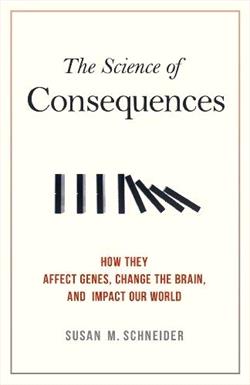Animal trainers, teachers, pet owners, and parents who are new to science-based teaching often ask if there is proof that positive reinforcement works better than aversives as if the research doesn’t exist. Hundreds of studies have been performed that have revealed many adverse effects of punishment. And in The Science of Consequences: How They Affect Genes, Change the Brain, and Impact Our World, author Dr. Susan Schneider, a behavior analyist, reveals the research that shows the effectiveness of positive consequences. She shares some of the findings in this recent interview.
Question:
In your book, The Science of Consequences: How They Affect Genes, Change the Brain, and Impact the World, you seem to recommend the use of primarily positive consequences to alter a person or animal’s behavior and tend to avoid negative consequences. Why is that?
Answer:
The problematic side effects of aversives are a major issue for people and animals. That doesn’t mean that aversives should never be used, of course (nor, in fact, is it possible to completely avoid them!), but the research suggests that in most cases, emphasizing positives is the way to go. There are many studies in which turning the ratio around from more negatives to more positives significantly reduced disruptive behavior. Studies by John Gottman show that couples with low positive-to-negative ratios are more likely to get divorced. The ratios make a difference in how well children learn vocabulary and language, the success rate of prison rehabilitation, and the success in schools.
Question:
Do any present-day school programs use this research successfully?
Answer:
As I mentioned in the previous answer, there are many studies in which turning the ratio around from more negatives to more positives significantly reduced disruptive behavior. Looking more at academics, an early example of a specific program is the original Direct Instruction educational program of the 1960s, in which a reasonably high positives-to-negatives ratio was built in. There’s a lot of research on its successes and those of its later permutations. A number of current programs similarly incorporate a reasonably high ratio–the KIPP charter schools, for example. (Refer to Ch.14 of The Science of Consequences). One well-known example was depicted in the film Stand and Deliver. The main character, Jaime Escalante used a variety of methods to keep his math students motivated, including providing plenty of rewards for hard work and achievement. “If motivated properly, any student can learn mathematics,” he said. For example, Escalante and his students regularly wore team jackets and studied together.
Question:
You also talk about intrinsic vs extrinsic rewards, can you explain the difference?
Answer:
Yes, extrinsic rewards come from outside, like paychecks or praise. Intrinsic rewards don’t; the activity itself is rewarding. People work to be able to go dancing or skiing because those activities are intrinsically reinforcing for many. For some dogs, playing fetch can be an intrinsic reward. No food or praise or petting needed!
Question:
You talk about providing more positive consequences, but teachers, college professors, and employers often point out that it seems that, in present day, kids are rewarded too much and as a result they are unwilling to work hard. Can positive consequences have a negative effect?
Answer:
Indeed, anything can be overdone, and that certainly includes praise. Carol Dweck has done some of the research in this area. The idea in many cases is to use shaping, and gradually thin out any extrinsic artificial rewards to the point that the natural rewards take over. Reading is a great example. Learning the alphabet is generally not intrinsically rewarding, but parents and preschool teachers praise progress, expecting steadily closer approximations to a complete recital as children learn. Reading simple words starts the transition to natural rewards: I still remember the thrill when I was able to read part of a restaurant menu.
For animals, Karen Pryor is among the experts pointing out that you might use a clicker and a high rate of reinforcement only when a new behavior is being taught. Once it’s established, you can put the clicker away (see Pryor’s Don’t Shoot the Dog). Occasional variable rewards, such as praise, can be sufficient to maintain it, and sometimes natural/intrinsic rewards help.
Question:
You talk about how learning through positive consequences also affects genes and has a positive effect on the brain. What do you mean and how might that affect the pets we are living with?
Answer:
Neuroscientists and geneticists, in partnership with behavior experts, have now discovered many ways in which all parts of the nature-nurture system interact. Learning from consequences has been shown to increase the number of synapses in the brain, for example—in adult people and animals as well as in youngsters. The benefits of enriched environments that include learning are many, and those results apply for animals as well as people. Any sort of learning changes the brain, including punishment, but reward-based enrichment has been shown to increase synapse formation.
Stay tuned for part 3!



